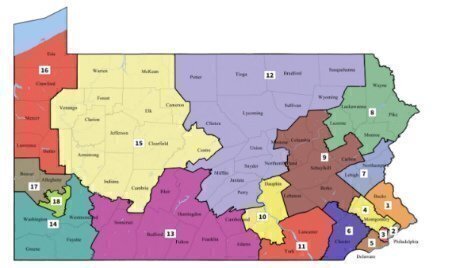In a unanimous ruling Monday afternoon, a three-judge federal court in Harrisburg, PA, threw out a challenge by Pennsylvania Republican officials and members of Congress about a new map for the election of the state’s 18 members of the U.S. House of Representatives.
 That ruling, offering no view on the constitutionality of the map drawn up by the Pennsylvania Supreme Court, left the GOP challengers with only attempted trips to the Supreme Court to pursue their claims. The Supreme Court has taken no action yet on one challenge that has been pending before the Justices for almost two weeks.
That ruling, offering no view on the constitutionality of the map drawn up by the Pennsylvania Supreme Court, left the GOP challengers with only attempted trips to the Supreme Court to pursue their claims. The Supreme Court has taken no action yet on one challenge that has been pending before the Justices for almost two weeks.
If the Justices do not step in on the side of the GOP challengers, Pennsylvania state officials will go forward with already unfolding plans based on the new House districting lines laid down by the state’s highest court.
In Monday’s decision by a three-judge U.S. District Court, the panel described the issues before it as being “of high importance to our republican form of government” and “of particular salience to the voters” of Pennsylvania. But the judges concluded that those issues could not be raised in this case by the two GOP figures in the state legislature or by eight currently serving GOP members of the House.
It said there would be no way that the legal gaps in the Republicans’ challenge could be filled even if it were to give them the chance to attempt to do so, and thus dismissed their lawsuit entirely, with no chance to revive it.
The GOP challengers do have the option now of appealing that decision to the Supreme Court. Federal law provides that disputes over congressional districting go first to special three-judge trial courts, and appeals from those courts go directly to the Supreme Court, bypassing the federal courts of appeals.
The Supreme Court may show its hand on the Pennsylvania controversy when it acts on an already pending plea by the two top GOP members of the state legislature to bar the use of the House districts crafted by the state Supreme Court. That plea technically has been ready for action by the Justices for 13 days.
Meanwhile, using the districts drawn by the state court, more than 180 candidates for seats in the House from the state are circulating nominating petitions. Tomorrow is the last day for them to seek voters’ signatures.
The case before the Harrisburg federal court sought to raise the same two issues under the federal Constitution that are at stake in the case awaiting action by the Supreme Court. The arguments are that the state Supreme Court violated the Elections Clause of the Constitution’s Article I by drawing new districts on its own and by failing to give the state legislature sufficient time to pass a bill to lay out the district boundaries.
But before the three judges could rule on those complaints, that court had to be satisfied that it had jurisdiction to do so. The federal Constitution requires anyone suing in a federal court to prove that their lawsuit involves a live “case or controversy.” Such a controversy must be real and not speculative.
In order to file such a lawsuit and claim that the court has power to decide it, those suing must show three things: that they will be directly harmed by the government action they seek to challenge, that their legal harm will have been caused by that government action, and that if they win the result will remedy their harm.
Those were the legal tests that the three-judge court concluded had not been met, and could not be met, by the two legislative officials and by the eight current House members from Pennsylvania.
The voters who were defending the state court’s map in the Harrisburg court, along with the two Pennsylvania election officials who joined in that defense, had focused much of their arguments on the claim that the three-judge court lacked the power to decide. That, in essence, was the way they won.
Having found no basis for ruling, the three judges did not give their own views on whether there had been a violation of the Elections Clause.
The proceeding now awaiting action by the U.S. Supreme Court is a temporary matter, in which the two leaders of the GOP-controlled legislature are seeking an order to block the use of the state court’s map until those two lawmakers can contest it in a forthcoming appeal from the state Supreme Court. If the delay request is denied, that will allow the current electioneering activity going on in the state to continue, leading up to the primary election on May 15.
Legendary journalist Lyle Denniston has written for us as a contributor since June 2011 and has covered the Supreme Court since 1958. His work also appears on lyldenlawnews.com.






